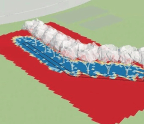Peri-urban territories are defined by the intersection of urban and rural lands located at the fringes of an urban centre. They are dynamic territories undergoing constant transformation due to the multi-scalar processes brought about by urbanization. Peri-urban territories are framed by their local context and are specific to both place and time.1 Almost always becoming urban through a transformation of the rural, the process of peri-urbanization is often perceived as an improving process, as part of an urban-rural continuum of rural and urban zoned land. However, in many cases, this conversion can occur without a proper investigation of the collective and cumulative social and ecological value of these lands.
Peri-urban areas have a diverse array of functions. These functions are either a requisite of urban development, while being at the same time physically Processes of peri-urbanization also commonly result in land being spatially fragmented, agricultural uses being dislocated and the water quality of surrounding systems – wetlands, creeks, catchments and estuarine areas – being reduced. This is despite such systems and agricultural and biodiverse areas providing essential ecosystem services that contribute to the health and wellbeing, liveability and resilience of human populations across a city’s entire metropolitan area. In Australia, peri-urban territories typically take the form of lower density, aging populations within rural areas surrounding our coastal urban metropolises. As land areas, they are subject to political, legal, governance and customary institutions. This also means we cannot (nor should we) ignore the intersection and unequal power distribution of settler-colonial concepts of land and land ownership with those of Aboriginal and Torres Strait Islander people, whose complex systems of land care and management of Country have been in place since time immemorial.




